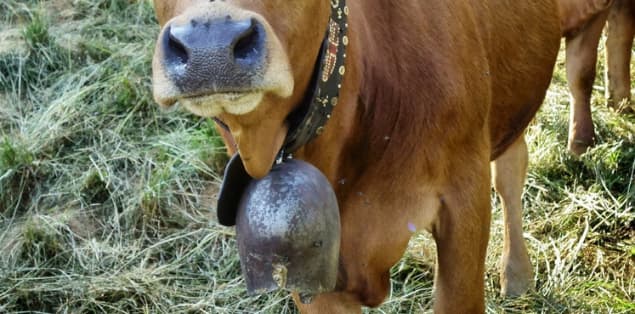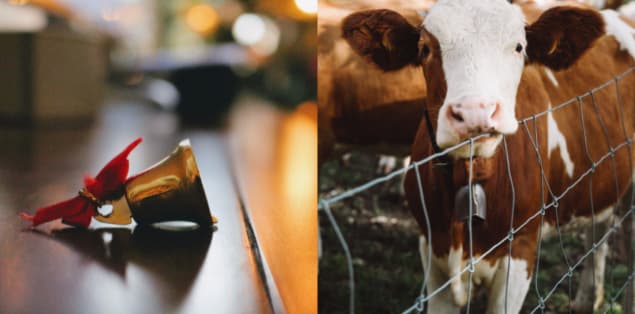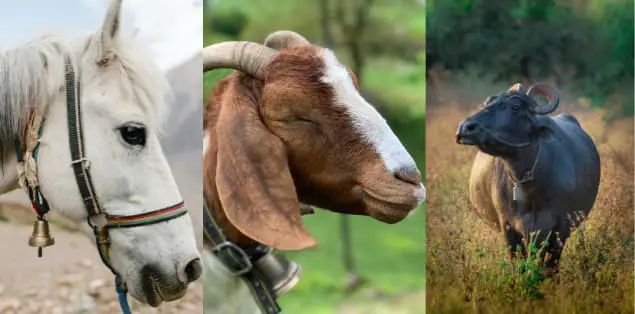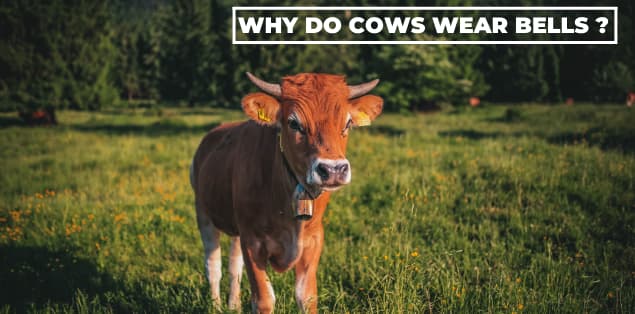So, why do cows wear bells? It isn’t easy to imagine a more idyllic picture of farm life than cows wearing bells wandering peacefully across a meadow as cowbells softly ring.
But have you ever wondered why cows wear bells in the first place? And the more you ponder it, the odder it seems.
What’s the point of this? When did this tradition start? Is there a specific reason why cattle wear bells?
We’ll examine cow bells in further depth in this post, including their unique historical usage and the traditional festivals and festivities when they’re employed. We’ll also look at some recent studies on whether or not it’s ethical to force cows to wear bells.
What Does a Cow Bell Symbolize?
Cowbells have been used in civilizations all across the globe for thousands of years. In the beginning, farmers crafted bells out of wood or pottery, but as time went on, farmers started putting bells made of metal around the necks of their cows.
Merriam-Webster defines a cowbell as a bell put around a cow’s neck that makes a sound that farmers use to find the cow. Though it may seem unusual, tying a bell around a cow’s neck is a centuries-old tradition with good cause.
Cattle have bells on them, so farmers know where they are at all times. Bells may be heard from a vast distance, making it simpler to find cows that are far away. Also, if a cow goes missing, a set of bells may aid locate it.
Aside from that, cow bells also prevent farmers and other people on foot from being hurt by cows that approach or charge.
People working close to the animals can use the bells as an early warning system to take necessary action if a cow is approaching.
Aside from the stated rationale, many cow owners may also use a bell to distinguish their cow from a cow belonging to another fellow.
Why Do Swiss Cows Wear Bells?

It’s easy for grazing cattle to become lost in Switzerland, a mountainous nation. It is a common problem even in the alpine regions, where some cows spend the summer.
The custom of affixing bells to cows as an identification method stretches back many centuries. The cow wears a bell around its neck that has the bell fastened to it.
The primary purpose was to enable a shepherd to maintain tabs on the whereabouts of their farm animals at all times. Because the cows spend most of their time grazing together in herds, much noise is produced.
The shepherds decided to employ this strategy to find their cows. They were seen grazing in open hilly places and even on the mountain pastures themselves. Because of the abundance of rocks and small hills in these places, tracking down a lost cow might be difficult.
Livestock herders can hear cows wearing cowbells across the high alpine valleys, even where there may be obstructions to one’s line of sight. Nowadays, farmers and shepherds employ electronic tags and systems with GPS to find lost cows, as you may have imagined.
In addition, there is a long-standing custom of adorning these cows with bells in Switzerland. In Switzerland, farmers tie bells around a cow’s neck to fend off evil, protect livestock with faith, and keep track of their location.
The spring season in Switzerland marks the beginning of the snow’s retreat. After that, people take the cows wearing cowbells to the alpine regions at a high altitude. They are free to graze here.
As soon as summer is over, the cows begin their journey back down the valleys and toward the villages. Then, as part of the festivities, people wove the floral garlands onto cows’ horns as a decoration.
How Do Cows Wear Bells?
The owners of cows put cowbells around their cow’s necks. Cowbells are bells that cows wear for various reasons, chief among them being safety. Neighbors are made aware of the cows’ presence by the sound of the bells. They also help their owners keep track of their herd’s whereabouts over large swaths of land.
Earlier, farmers tied pottery bells around the cow’s neck. Later on, people started using iron, bronze, brass, copper, or wood to make metal bells and clappers. Historically, farmers made the bell collar of leather and wood fibers.
Cowbells are made in various ways, depending on the region and culture. Nowadays, people use thin, flat-coated sheet metal to construct most cowbells.
Farmers connect bells to dairy cows with the help of a huge collar. For safety reasons, leather collars are the most common choice; however, cattle owners have the option of using nylon or vinyl collars instead. A collar that fits snugly around the cow’s neck and won’t come off due to scratching is essential.
The owner must periodically inspect and adjust the collar to avoid sores or other injuries to the cow’s neck.
Cow bells vs. Jingle Bells

In contrast to traditional dinner bells or jingle bells, the bells that cows and other animals wear are unique. Compared to decorative holiday bells, livestock bells and cowbells sound significantly louder and last longer.
The bells attached to cattle are such that one can hear them from significant distances, and they need to have a loud tone to compete with the natural noises present in their surroundings.
The bell ring must be unique for owners of free-roaming livestock to recognize the bells, even if their animals are far away.
The size of the bell is often determined not only by the local custom in a given region but also by the materials that are easily accessible there.
Do Bells Hurt Cows?
Yes, cowbells harm the cows in some manner or another. Because the bells are so heavy, they make an obnoxious and disruptive noise. Cowbells may be deafening in their volume. So what else could be upsetting if not the weight they carry and the constant din they hear?
Some individuals believe that wearing a bell damages the animals, causing hearing loss, weight loss, and other issues, although most cattle owners disagree.
A group of animal welfare rights activists argues that the safety advantages of cattle owners’ bells do not exceed the damage they may inflict on a cow’s hearing, notwithstanding their claims. Instead of utilizing cowbells, some people oppose them and advocate using GPS trackers on the cows.
Do Cows Like Having Bells?
No, the cows do not like having bells. Moreover, cowbells weigh up to five and a half pounds. This weight is a lot, even for a massive animal like a cow.
According to research, cows who wore bells weighing five and a half pounds chewed and consumed less food than cows that did not wear the bells. The researchers pointed out that it was unclear if the animals were upset by the noise the bells made or the weight of the bells themselves.
Zurich-based farmers reacted angrily to this study’s first public reporting in 2014, saying it was inaccurate and that cowbells are integral to Swiss culture.
It is a well-known fact that cows have more acute hearing than humans. In addition, the bells can produce sounds at a decibel level that is higher than 100, which is the sound that a jackhammer makes.
Cowbells used for cattle are larger and more obnoxious than those for other animals such as sheep and reindeer. Cowbells are commonly referred to as “cow bells” because of their widespread use with cattle.
The cowbells are heavy, but they also cause irritation and blisters on the animals’ necks due to the friction. For example, it would be to replace a light with chips in the information era. The shepherd can locate his herd using the smartphone at that point.
What Other Animals Wear Bells?

Besides cows, many farm animals wear large bells around their necks, including sheep, goats, and pigs.
It’s worth noting that goats, sheep, and reindeer all wear bells on their heads rather frequently due to the same reason. Wrapping bells around the necks of cows, goats, lambs, and reindeer is particularly popular throughout Africa, Asia, Western Europe, Mediterranean countries, and Latin America.
In contrast, animals from the other parts of the globe also wear bells, albeit not to the same extent as those from the places described above.
Some pets also wear bells nowadays. Cats and other tiny predators may be given collars with bells to deter them from the prey, and a bell can be attached to their collars to warn birds and other small animals of an approaching cat.
Final Words – Why Do Cows Wear Bells?
To wrap it up, cows wear bells mainly as a matter of custom. Cowbells’ original purpose is now primarily irrelevant since farmers have access to many other tracking methods.
However, farmers may still use cow bells to find their livestock while nearby but not in sight.
Next time, when someone asks you, “why do cows wear bells?” we hope that you will be able to reply to them with conviction.
